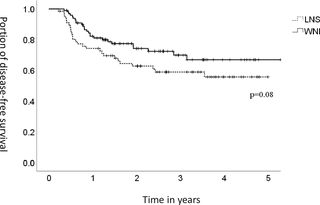
by Sheng-Yow Ho, Wan-Chen Kao, Sheng-Yen Hsiao, Sheng-Fu Chiu, Sung-Wei Lee, Jia-Chun Chen, Li-Tsun Shieh
Objectives
Adjuvant radiotherapy is the standard of care in locally advanced head and neck cancers. The radiation field is correlated with the surgical field in the adjuvant radiotherapy setting; therefore, tailoring the irradiation field is reasonable.
Materials and methods
We retrospectively analyzed patients with oral cavity and oropharyngeal cancers included in the cancer registry between 2015 and 2019 in the study hospital. Patients who underwent whole-neck irradiation (WNI) were compared with those who underwent lower-neck–sparing (LNS) irradiation.
Results
A total of 167 patients with oral cavity and oropharyngeal cancers were included in the study. Cancer recurrence was recorded in 33% of the patients. The rate of recurrence of oral cavity and oropharyngeal cancer at neck level IV was 8%. The 2-year incidence of level IV recurrence was lower in the WNI group than in the LNS group (2% vs. 10%; p = 0.04). The 2-year disease-free survival rates were 75% and 63% in the WNI and LNS groups, respectively (p = 0.08).
Conclusion
The rate of level IV recurrence was higher in the LNS group than in the WNI group. Trends of improvement in disease-free survival with lower-neck irradiation suggested that it is premature to consider LNS irradiation as daily practice in patients with oral cavity and oropharyngeal cancer.


